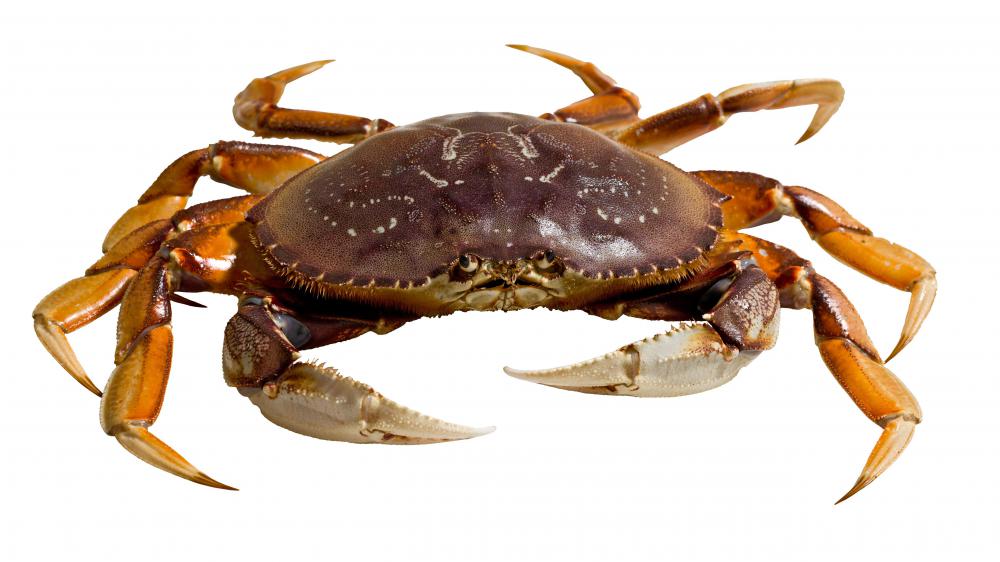At AllThingsNature, we're committed to delivering accurate, trustworthy information. Our expert-authored content is rigorously fact-checked and sourced from credible authorities. Discover how we uphold the highest standards in providing you with reliable knowledge.
What is a Horn Shark?
The horn shark is a type of marine fish belonging to the shark family Heterodontidae. These sharks live along the continental shelf in the subtropical and warm temperate seas of the Pacific Ocean stretching from the coast of Baja California as far north as central California. Horn sharks are gray or brown in color and have speckled skin with lots of small black spots all over. In appearance, the horn shark is distinct from other sharks because it has a short, blunt head with bony ridges over its eyes in front of its dorsal fins. It takes its name from these ridges because they look like two horns.
Horn sharks are one of the smaller species of shark. The maximum length of this shark is about 4 feet (122 cm) but the average adult usually is about 3.2 feet (97 cm). Hatchlings range in size from 6-7 inches (15-17 cm).

Water temperature controls the habitat of the horn shark, because it prefers waters with a temperature of more than 68 degrees Fahrenheit (20 degrees Celsius). When waters are warm, the horn shark will live in shallow areas and is most often found at depths from 7-36 feet (2-11 m). After waters turn colder in wintertime, horn sharks move to depths usually greater than 98 feet (30 m) in order to keep their bodies warm enough. Other than responding to water temperature, horn sharks actually do not cover much open sea. Generally, they stay within a home range that is about as large as an Olympic-sized swimming pool.
The horn shark, which is also called a bullhead shark, differs from other types of sharks because it prefers to stay close to the bottom of the ocean. During the day, the horn shark likes to hide in a favorite resting place, which usually is in a crevice, among rocks or in a bed of seaweed or kelp. It comes out at night to hunt for prey such as shrimp, snails, sea urchins and crabs. Horn sharks are not good swimmers and, in fact, they will use their pectoral fins instead to crawl along the ocean floor to search for prey.
Mating season is in mid-winter. Over the next few weeks, the female deposits about 24 eggs on the bottom, which she then places in crevices to protect them from predators. It takes about six to nine months for an egg to hatch.
Frequently Asked Questions
What is a Horn Shark and where can it be found?
A Horn Shark is a small, slow-moving species of shark known for its distinctive horns above each eye and a short, blunt head. They are typically found in the coastal waters of the western North American coast, from California to the Gulf of California. They prefer rocky bottoms and kelp forests where they can easily camouflage.
How does the Horn Shark reproduce?
Horn Sharks are oviparous, meaning they lay eggs. Females deposit spiral-shaped eggs in crevices between rocks, which they carefully select and often guard. The eggs have a hard casing to protect them from predators. It takes around six to ten months for the embryos to develop and hatch, depending on water temperature.
What do Horn Sharks eat?
Horn Sharks have a diet that primarily consists of hard-shelled prey such as mollusks, crustaceans, and sea urchins. Their powerful jaws and molar-like teeth are specially adapted to crush these tough shells. They are nocturnal feeders, relying on their strong sense of smell to locate food at night.
Are Horn Sharks dangerous to humans?
Horn Sharks are considered harmless to humans. They are a docile species and tend to be more active at night, avoiding contact during the day. Their small size and sluggish nature make them less threatening, and there are no known instances of a Horn Shark causing harm to a person.
How do Horn Sharks navigate their environment?
Horn Sharks rely on their keen sense of smell to navigate and find food. They also have sensory organs called the lateral line system, which detects vibrations and movement in the water, helping them to sense prey or predators nearby. Their bottom-dwelling habits mean they often use the contours of the ocean floor to get around.
What conservation status does the Horn Shark have?
According to the International Union for Conservation of Nature (IUCN), the Horn Shark is currently listed as "Least Concern." However, they are vulnerable to habitat degradation, pollution, and the impacts of commercial fishing. Conservation efforts are important to ensure their populations remain stable and to mitigate potential threats to their coastal habitats.
AS FEATURED ON:
AS FEATURED ON:











Discuss this Article
Post your comments